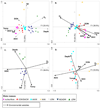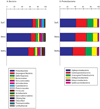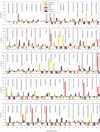Water mass-specificity of bacterial communities in the North Atlantic revealed by massively parallel sequencing
- PMID: 21143328
- PMCID: PMC3057482
- DOI: 10.1111/j.1365-294X.2010.04932.x
Water mass-specificity of bacterial communities in the North Atlantic revealed by massively parallel sequencing
Abstract
Bacterial assemblages from subsurface (100 m depth), meso- (200-1000 m depth) and bathy-pelagic (below 1000 m depth) zones at 10 stations along a North Atlantic Ocean transect from 60°N to 5°S were characterized using massively parallel pyrotag sequencing of the V6 region of the 16S rRNA gene (V6 pyrotags). In a dataset of more than 830,000 pyrotags, we identified 10,780 OTUs of which 52% were singletons. The singletons accounted for less than 2% of the OTU abundance, whereas the 100 and 1000 most abundant OTUs represented 80% and 96% respectively of all recovered OTUs. Non-metric Multi-Dimensional Scaling and Canonical Correspondence Analysis of all the OTUs excluding the singletons revealed a clear clustering of the bacterial communities according to the water masses. More than 80% of the 1000 most abundant OTUs corresponded to Proteobacteria of which 55% were Alphaproteobacteria, mostly composed of the SAR11 cluster. Gammaproteobacteria increased with depth and included a relatively large number of OTUs belonging to Alteromonadales and Oceanospirillales. The bathypelagic zone showed higher taxonomic evenness than the overlying waters, albeit bacterial diversity was remarkably variable. Both abundant and low-abundance OTUs were responsible for the distinct bacterial communities characterizing the major deep-water masses. Taken together, our results reveal that deep-water masses act as bio-oceanographic islands for bacterioplankton leading to water mass-specific bacterial communities in the deep waters of the Atlantic.
© 2010 Blackwell Publishing Ltd.
Figures








References
-
- Agogué H, Brink M, Dinasquet J, Herndl GJ. Major gradients in putatively nitrifying and non-nitrifying Archaea in the deep North Atlantic. Nature. 2008;456:788–791. - PubMed
-
- Andersson AF, Riemann L, Bertilsson S. Pyrosequencing reveals contrasting seasonal dynamics of taxa within Baltic Sea bacterioplankton communities. ISME Journal. 2009;4:171–181. - PubMed
-
- Aristegui J, Gasol JM, Duarte CM, Herndl GJ. Microbial oceanography of the dark ocean's pelagic realm. Limnology and Oceanography. 2009;54:1501–1529.
-
- Azam F, Fenchel T, Field JG, et al. The Ecological Role of Water-Column Microbes in the Sea. Marine Ecology Progress Series. 1983;10:257–263.
-
- Baas Becking LGM. Geobiologie of inleiding tot de milieukunde. The Hague, the Netherlands: 1934.
Publication types
MeSH terms
Substances
Grants and funding
LinkOut - more resources
Full Text Sources
Other Literature Sources

